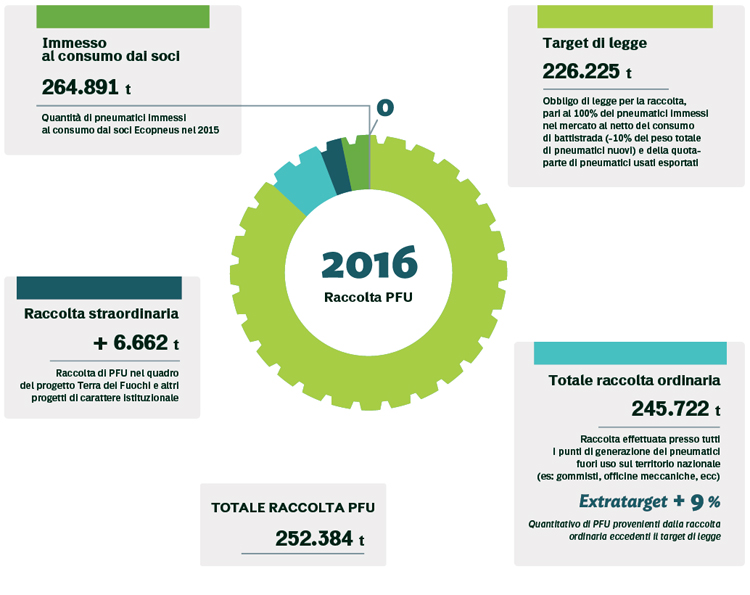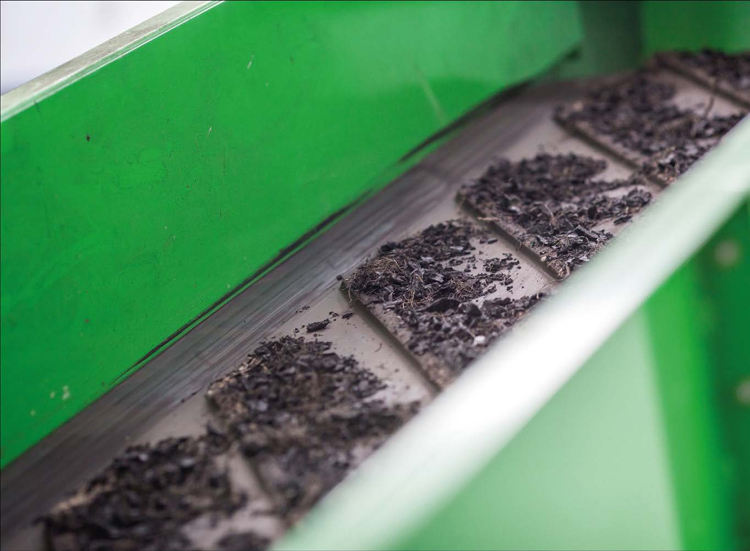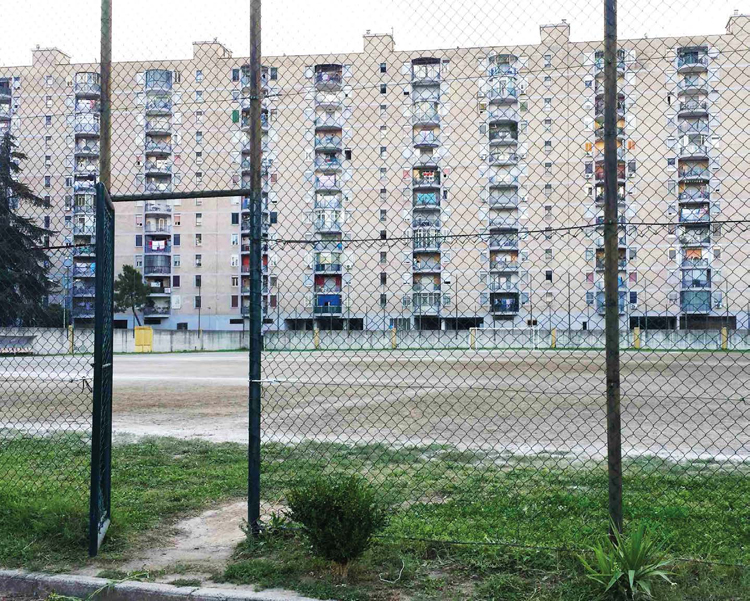Where is it that the circular economy knits together with the ethical economy? To casual observers – those interpreting recovery and recycling of materials exclusively taking into account only the savings in raw materials on the final invoice – the question may seem bizarre. But this would be an incorrect and incomplete interpretation. It would be a balance that overlooks all possible dividends, direct and indirect social and environmental consequences. As for many years Edward Goldsmith – one of the fathers of ecology – has tried to explain, it is not possible to tackle any event or problem without considering the chain of events and players involved in it.
Reduction and therefore the disappearance of waste or rather of discarded stuff has far wider and longer lasting implications than the mere recovery of matter.
The data and examples offered by the latest report by Ecopneus help us answer the initial question, i.e. where the circular and ethical economy intersect.
They intersect when we talk about employment. Job creation, whether it is ex-novo employment or qualitative improvement of part of the existing employment, is already quite a social result. In this regard, Ecopneus informs us that if 100% of end-of-life tires were recovered to obtain matter, today, in Italy, new conditions could create 6,000 new jobs.

Or the events occurred in Scampia, the so-called Land of Fires. In these areas devastated by crime and adopted in the collective imagination as an example of border land where law and health surrendered to violence and pollution, precisely here, the circular and social economy knit together as links of the same chain.
Here, Ecopneus collected over 16,000 tonnes within the “Protocol with the Ministry of the Environment for extraordinary interventions to collect ELTs and in the Scampia neighbourhood in particular, as the tail operation of a tire recovery dumped in the Naples and Caserta provinces and a proper football field is under construction, made with recycled rubber granules from ELTs. “This is a sign of the will to fight degradation of abandonment and illegal fires, bestowing a new future to materials that were once waste and new opportunities to young people that are the future of this Land” explains Giovanni Corbetta, Ecopneus’ General Director.
6,000 Jobs from Tire Recycling
The study, carried out by the Foundation for sustainable development on behalf of Ecopneus, with regard to employment analysed the two scenarios – Full Energy Recovery and Full Recycling – to try and understand which one is able to create most jobs. We won’t give too much away if we say that even here the comparison has shown that recycling offers a higher number of jobs, although such transition needs a conceptual leap. To understand, not on an ideological but rather on a scientific level, that environmental conservation is more advantageous even in social terms.
As far as the employment and economic balance is concerned, the study analysed the direct, indirect and induced effects of expenditure associated with the management of the supply chains, i.e. considering both the direct effects of management and those induced and indirect that such expenditure causes on the economic system through the purchase of intermediate and semi finished goods and services and of the effects produced by the rise in the income of those involved in activities of consumption.
The study also considered the time (a few years) necessary for the development of infrastructure and supply chains for a complete recycle or for a whole energy recovery of 400,000 tonnes of ELTs. Once up to speed, as the analyses say, the new added value produced by the Full Energy Recovery scenario would amount to €91 million, compared to the 110 million offered by the Full Recycling one. Similarly, added employment (calculated in standard work units) would go from 1,433 units when sending ELTs to cement factories to 1,727 with the same 400,000 tonnes of ELTs recycled. As we said before, there is no comparison between recycling and energy recovery; the former wins with €19 million of added value and over 300 more jobs.
Regarding direct, indirect and induced effects deriving from savings for Italy associated with the reduction of imports of raw materials replaced from ELTs recovery in the two scenarios, figures are more significant. The avoided expenditure for imported raw materials, rubber, steel, carbon coke etc. allows, as the study explains, to make available economic resources to free new investments on a national scale, followed by higher available income and domestic consumptions. The real benefit in economic and occupational terms of recycling would lie precisely here. The difference in added value and new employment produced in the two scenarios is beyond an order of magnitude, with €30 million for Full Energy Recovery as opposed to €392 million of Full Recycling and 494 new jobs as against over 6,000.
To achieve full recycling of ELTs compared to the mere energy recovery would allow to generate over €360 million of extra added value every year and almost 6,000 new jobs. A true revolution.
“Over the last few years, Ecopneus has committed to maximizing matter recovery, following the EU indications and the principles of the circular economy” says Corbetta. “Full recognition from non-waste to rubber granules and rubber powder, would allow a qualitative leap in the recycling/energy relation, better environmental, economic and employment benefits.”
Also, in more detail, over 6,000 workers from this resource could contribute 400 million of added value and CO2 savings equal to the emissions by 300,000 cars, natural resources equal to 106 Eiffel towers and water of 500 Olympic-size swimming pools.
Over the last year, Ecopneus collected more than 245,000 tonnes of ELTs, 1 million and 400,000 since the beginning of its operation. On average, it manages 250,000 tonnes of ELTs yearly, 56% of which destined for matter recovery.
The overall value of such system is €63 million of economic value distributed each year to a growing industrial supply chain already employing about 700 people.
Ecopneus with the Foundation for the sustainable development has also carried out a study to measure the potential advantage of ELTs recovery in environmental, economic and employment terms. The intersection between circularity and ethics we mentioned before.
“The study – explains Andrea Barbabella, of the Foundation for the sustainable development and responsible for the study – reveals that the main benefit in economic and employment terms of ELTs recovery is the savings in current expenditure associated with avoided imports of raw materials, which would make available economic resources for new investments on a national scale followed by higher incomes and domestic consumption, making for substantial “systemic” advantage for Italy.”
ELTs management throughout Europe, Italy included, occurs through two recovering ways: the first is about recycling materials and in particular rubber polymers, which can be used as secondary raw material as a replacement for virgin rubber for the production of new goods; the second is about the recovery of fuels derived for the production of energy, thanks to the high calorific value of rubber.

It goes without saying that the European policies regarding the circular economy push for the first solution and, as the figures on the study by the Foundation for sustainable development and Ecopneus show is just as well, in terms of obtained and obtainable environmental results.
Then, if we analyze the impact on human health, the recovery of 400,000 tonnes of ELTs with the use in cement factories, there is a positive although modest balance, with a saving of about 30 years. While the Full Recycling scenario, thanks to avoided emissions, the saved years soar to 749 – as the study shows – and recycling is by far the most preferable option in terms of life cycle from a health point of view.
It is true that the so-called “discarded stuff” is high and that 250,000 tonnes of ELTs may tempt the market of energy recovery of cement factories but in Italy it has a limited absorption capacity. However, in other parts of the world such as North Africa, Korea, Eastern Europe, the demand is higher. Not only would it be easy because there is already demand for ELTs, but it would also be efficient from the viewpoint of costs because it would allow savings for the business sectors and with everything connected with granulation, from staff to certification, just to give you an example.
But the immediate benefits of such process go against the far higher and longer lasting economic, environmental and health advantages of the model proposed by the circular economy, as shown with many examples by the Ecopneus study.
Figures and analyses, accomplished on the Italian sample but that can apply to the rest of the Union and that confirm the direction in which the European policy is going. Sometimes some member States, including Italy, is faced with red tape obstacles that make it difficult to let it accept.

“To go down the path of matter recovery instead of that apparently easier of energy recovery is the underlying reason of the activity of our consortium: i.e. guaranteeing, through collection and recovery of ELTs, maximization of environmental and social benefits for the community, together with minimization of economic costs for the community, with full application of ethical, liability and legality principles in compliance with institutional, European and national policies,” explains Giovanni Corbetta, Ecopneus’s general director. “The circular economy is possible and the advantages are tangible. In order to implement it – warns therefore Corbetta – a cultural change is needed involving everyone, including citizens, companies and institutions. A cultural leadership is also necessary, which today is lacking.”
Report Ecopneus 2016, tinyurl.com/ycr92me9
Fondazione per lo sviluppo sostenibile, www.fondazionesvilupposostenibile.org
Info



